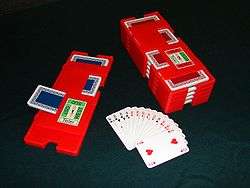Tarneeb
Tarneeb (Arabic: طرنيب , literally meaning trump, translit: ṭarnīb) also spelled Tarnibe and Tarnib and called hakam Arabic: حكم in the Persian Gulf region, is a plain trick-taking card game played in various middle eastern countries, most notably in the countries of the Levant and also in Tanzania. The game may be considered a variation of Whist, or a version of Spades.
 | |
| Origin | ULFG-II Roumieh |
|---|---|
| Type | Trick-taking |
| Players | 4 |
| Cards | 52 |
| Deck | French |
| Play | Counter-clockwise |
| Card rank (highest first) | A K Q J 10 9 8 7 6 5 4 3 2 |
| Related games | |
| 400 Arba3meyeh | |
History
Tarneeb was probably inspired by Iranians and many other Arabic card games, though many different nations throughout the Middle East claim that Tarneeb was created in their respective countries. Historically Tarneeb can be traced back to the Levant, more specifically Syria, Egypt, Lebanon, Jordan, and Palestine, however the game seems to have truly flourished only from the early 18th century on.
The game
The aim of tarneeb is to win a set of continuous hands. There are four players in partnerships of two teams. A standard 52 card deck is used, each suit ranking in the usual way from Ace (high) down to two (low). The game is played in a counterclockwise fashion. The teams stay together for all the games of a set. In tarneeb tournament, at the end of a set, the losing team is replaced for the next set.[1]
The two members of each team are seated across each other, often on a table in such a way that no player can see the cards of other players (see seating charting image). Either player of a team may collect the winning tricks.
The first dealer is chosen at random and after each hand the turn to deal passes to the right. The cards are shuffled and cut by the player to the dealer's left, and are all dealt out beginning with player to the dealer's right, one at a time or in groups of thirteen (13), so that everyone has 13 cards.
Bidding
The bidding begins with the first player to the right of the dealer and continues counter-clockwise. It consists of a number of tricks seven or above. A bid of more tricks outranks any bid of fewer tricks.
Each person can bid once, yet if any other player bids higher, one has the privilege of raising their bid, except in the case of passing a bid, wherein one is excluded from the bidding process.
- Some players use the option of telling their partner how good their cards are i.e., helpful, not helpful at all.
Playing
The objective of the bidding team is to take at least the number of tricks that they bid. The objective of the other team is to hinder the declarer team from reaching their declared bid.
The individual declarer leads to the first trick. Players counterclockwise must follow suit if they can; a player who has no cards of the suit led can play any card. A trick is won by the highest tarneeb (trump) in it, if any. If there are no tarneebs in the trick, the highest card of the suit led wins it. The winner of a trick leads to the next.
Playing exceptions
- In some regions, the declarer must start the first trick with his declared tarneeb suit. But in most cases they don't.
Scoring
Once all thirteen tricks are played, the scores of the two sides are calculated by adding the tricks each side has won. If the declarer team meets or exceed the number of bidded tricks, then they get the number of tricks they have, otherwise, they lose the bid number (subtracted from their score) and the opposing team gains the number of tricks that they have collected their own in score. It is possible, therefore, to have a negative score at some point. The set ends when one of the teams reaches forty-one (41) and the losing team is replaced for the next set.
A team can also win the game by either bidding or making a set of 13 tricks.
Scoring exceptions
- In some regions, a set ends when a team reaches 31 or 61 rather than 41.
- A team can not win if 13 tricks are won if a lower bet was offered (in Falamanki Dubai as per Mr. Rabih)
- A team can not win if their current score is below 0
Game strategies
- Keep Tarneeb Count: Every player should know how many tarneebs are out and how many are left at any point in the game. This is most crucial for the declarer who should always know how many tarneebs are out.
- Tashleeh: If you are the declarer, try to eliminate as many tarneebs from the game as possible.
- Ta'leem: If your partner is the declarer and you run out of tarneebs, signal to your partner what suit you want him to follow on the next trick by using a low card of that suit.
- Hints: If you want your partner to return the same suit on the next turn, slam the card on the table as you play. Note that this practice is not allowed in some areas and generally frowned upon as not very professional behavior.
- Na'f: When you finish a suit, throw the last card with a (flick) which hints your partner. This also is not always allowed.
- Second Lowest/Third Highest: for any trick, a good rule of thumb is for the second player to use the lowest card, and the third player to use the highest card.
References
- Hugh Miles, Playing Cards in Cairo, pg. 1, Abacus Software (2008) ISBN 0-349-11979-1